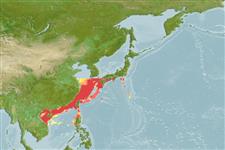Environment: milieu / climate zone / depth range / distribution range
Sinh thái học
Biển gần đáy; Ở đại duơng, biển (Ref. 51243); Mức độ sâu 10 - 200 m (Ref. 41299). Subtropical; 34°N - 15°N
Northwest Pacific: northeastern part of South China Sea (Philippines excluded) northward to Japan.
Length at first maturity / Bộ gần gũi / Khối lượng (Trọng lượng) / Age
Maturity: Lm 34.3 range ? - ? cm
Max length : 100.0 cm SL con đực/không giới tính; (Ref. 559); common length : 30.0 cm TL con đực/không giới tính; (Ref. 2115); Khối lượng cực đại được công bố: 9.7 kg (Ref. 40637); Tuổi cực đại được báo cáo: 26 các năm (Ref. 56606)
Các tia vây lưng cứng (tổng cộng) : 12; Các vây lưng mềm (tổng cộng) : 10; Tia cứng vây hậu môn: 3; Tia mềm vây hậu môn: 8. Body with many bluish dots when fresh. Shallow body, body depth 2 or more in SL. Transverse scales 6.5-7.5. All spines of dorsal fin tough and not elongated. Posterior margin of caudal fin black, lower margin white (Ref. 42199).
Occurs from 10 to 50 m depths, often on rough grounds, but also on softer bottoms. Also inhabits reefs (Ref. 9988). Adults migrate into shallower parts of their depth range to spawn in late spring and summer; juveniles occur mainly in the shallower areas. It is a popular food fish throughout its range. It is high-priced in Japan and used in various occasions such as wedding and festival. Feeds on benthic invertebrates, including echinoderms, worms, mollusks and crustaceans; also on fishes. Marketed live, fresh and frozen; eaten steamed, pan-fried, broiled, boiled and baked (Ref. 9988). Cultivated in cages (Ref. 9988). Used in Chinese medicine (Ref. 12166).
Conflicting descriptions of the reproductive style of this species have been reported, e.g., Ref. 34228 describe this species as being a gonochorist (Ref. 28504). After clarificatory analyses on the protogynous characteristics of this species, gonochorism is confirmed (Ref. 103751).
Eggleston, D., 1974. Sparidae. In W. Fischer and P.J.P. Whitehead (eds.) FAO species identification sheets for fishery purposes. Eastern Indian Ocean (Fishing Area 57) and Western Central Pacific (Fishing Area 71), Volume 4. FAO, Rome. (Ref. 2115)
IUCN Red List Status (Ref. 130435)
Threat to humans
Harmless
Human uses
Các nghề cá: tính thương mại cao; Nuôi trồng thủy sản: Tính thương mại; cá để chơi: đúng; Bể nuôi cá: Bể cá công cộng
Các công cụ
Special reports
Download XML
Các nguồn internet
Estimates based on models
Preferred temperature (Ref.
123201): 17 - 24.4, mean 21.8 °C (based on 143 cells).
Phylogenetic diversity index (Ref.
82804): PD
50 = 0.5156 [Uniqueness, from 0.5 = low to 2.0 = high].
Bayesian length-weight: a=0.01288 (0.01142 - 0.01453), b=3.03 (3.00 - 3.06), in cm total length, based on LWR estimates for this species (Ref.
93245).
Mức dinh dưỡng (Ref.
69278): 4.5 ±0.7 se; based on diet studies.
Thích nghi nhanh (Ref.
120179): thấp, thời gian nhân đôi của chủng quần tối thiểu là 4.5 - 14 năm (Preliminary K or Fecundity.).
Prior r = 0.22, 95% CL = 0.15 - 0.33, Based on 1 full stock assessment.
Fishing Vulnerability (Ref.
59153): High vulnerability (58 of 100).
Nutrients (Ref.
124155): Calcium = 48.2 [26.4, 91.9] mg/100g; Iron = 1.48 [0.51, 3.85] mg/100g; Protein = 20.6 [18.9, 22.2] %; Omega3 = 0.328 [0.152, 0.664] g/100g; Selenium = 33.6 [15.5, 66.8] μg/100g; VitaminA = 13.5 [4.1, 42.2] μg/100g; Zinc = 0.433 [0.220, 0.895] mg/100g (wet weight);
